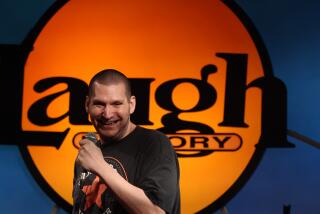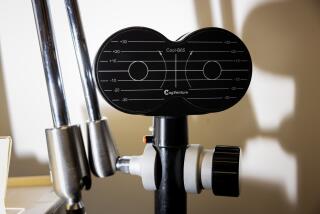Grasping for answers to autism
The recent report that autism rates are skyrocketing in California was bittersweet for many parents and children’s advocates. Although the study confirmed what they’ve long suspected, it did little to answer other questions or ease the fight for services.
Researchers have yet to identify what’s behind the 273% increase in autism cases between 1987 and 1998, detailed in the UC Davis report. And parents often get little guidance on treatments, therapies and long-term services, simply because doctors and other experts don’t know the answers.
Moira Giammatteo, a West Hills resident who quit her job to better manage the care for her 5-year-old autistic son, says the report could lead to better information -- and more options -- for parents. “There’s more attention now,” she said. “I think there’s reason to hope.”
Autistic kids typically begin to show signs of something amiss around age 2 or 3. They may be unable to make eye contact or communicate. Walled in their own worlds, they sometimes perform repetitive behaviors, such as rocking and hand flapping, and can become sensitive to sound or touch.
With families often willing to mortgage their houses and go into debt for the promise of expensive, unproven therapies, doctors say there’s a critical need for sound scientific studies establishing which treatments work.
“There is no one miracle cure for autism. If there was, we would have found it by now,” said Dr. Sarah Spence, medical director of the UCLA Autism Evaluation Clinic. “Something you heard about as a miracle cure is probably going to work in some kids. The key is to predict this response.”
More specialists are needed as well. Too few speech, behavior and mental health therapists have experience working with autism, and parents often must wait months to see those who do. Some parents don’t get such help at all.
Furthermore, few social, medical and residential services are available for autistic children moving into their teenage and adult years. What works when a child is 4, 5 or 6 doesn’t necessarily help when that child gets older, Emily Iland of Santa Clarita said. Her autistic son, Tom, now 18 and attending college, is among many young adults who need medication for anxiety or depression stemming from social isolation. “They’re smart enough to figure out they’re different and don’t know how to fix it,” she said.
In the complex and confusing world of autism treatment, only one thing is sure, said Dr. Susan Schmidt-Lackner, who oversees autism programs at UCLA and at Vista Del Mar Child and Family Services in Los Angeles: “The earlier we diagnose the kid, the better the prognosis.”
She said autistic children need 30 to 40 hours of structured, one-on-one therapy each week.
Experts say each child needs a range of therapies targeting his or her ability to speak and communicate, to form relationships with others, and to control repetitive behaviors and their sensory overload. “The cardinal rule when we’re looking for therapies ... is to do no harm,” Schmidt-Lackner said.
Moira and Michael Giammatteo understand the difficulty of finding appropriate treatment. They constantly explore non-drug treatments for their son, Vico, whose language skills, ability to make eye contact and overall health improved on a diet that avoids wheat and milk products.
Although the school district provides 40 hours a week of intensive behavioral intervention, Moira recently was trained in “relationship development intervention” therapy to bolster what her son is getting from the district.
The Giammatteos have consulted with doctors in Florida and Illinois, and spend nearly $200 a month for supplements.
“We have tried a lot of things,” said Moira, who also hosts a support group for parents. “We are leaving no stone unturned.”
Among behavioral therapies with the best track records are applied behavioral analysis and discrete trial training, which reward children for mastering certain tasks. Another is floor time, in which the play between therapist and child simulates other social interactions.
But Schmidt-Lackner said that because so much about autism is not known, it’s hard to rule out even partially discredited therapies. “If it works for one kid, it’s as if you’ve saved an entire world,” she said.
At the same time, “I have to help my clients be savvy consumers, not plug into the cure du jour and get themselves ripped off. Unfortunately, autism is an epidemic, but it’s also a business.”
Among more promising approaches, some doctors say, is the amino acid l-carnosine, which improves language skills in some children.
But while doctors debate which therapies work best, the fundamental issue facing families is whether their children can get the kind of attention that gives them a fighting chance to get better.
Sherlene Allen, executive director of the Burbank-based Autism Alliance and the mother of autistic boys ages 3 and 4, said: “There are just not enough funds to provide adequate or appropriate services to all the children [and adults] with autism who need them.”
*
(BEGIN TEXT OF INFOBOX)
Easing effects of the disorder
Although nothing cures autism, medications developed for other disorders can alleviate some symptoms.
Antidepressants (Prozac, Paxil, Zoloft and Celexa) can be prescribed in very small doses to reduce repetitive behaviors and anxiety and to improve social interactions.
Antipsychotic medications (Risperdal, Zyprexa, Seroquel and Geodon) can reduce outbursts of aggression, self-injury and impulsiveness, and ease irritability and tantrums.
Stimulants (Ritalin and Adderall) can help a child focus.
Anticonvulsants (Tegrital and Depakote) can help children with abnormal brain activity and can reduce major outbursts.






